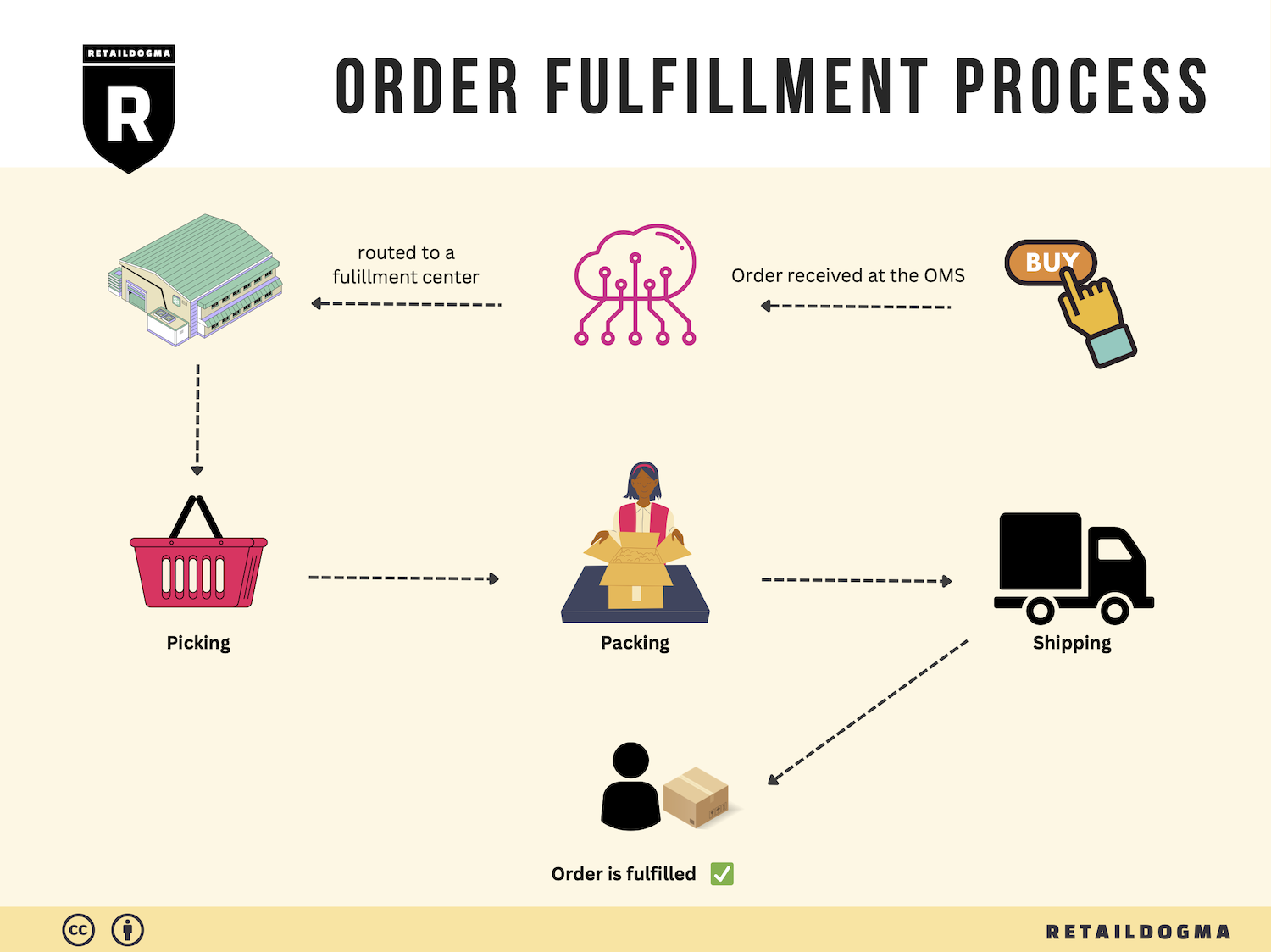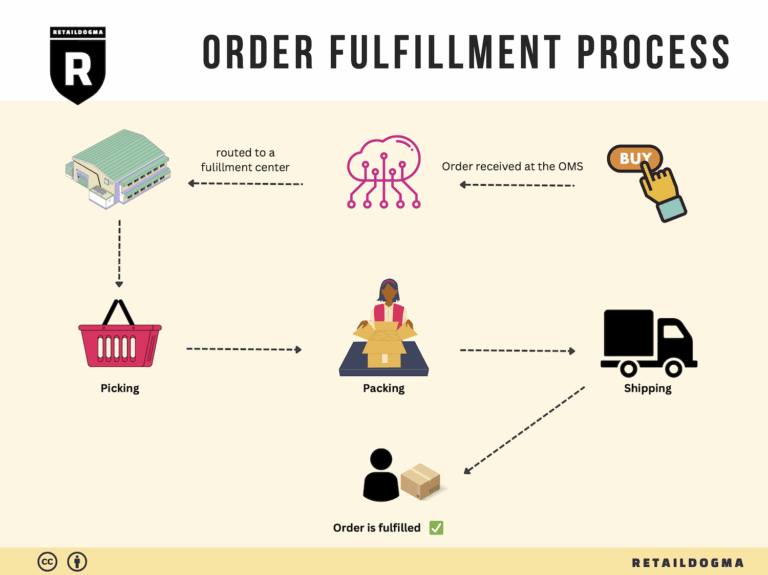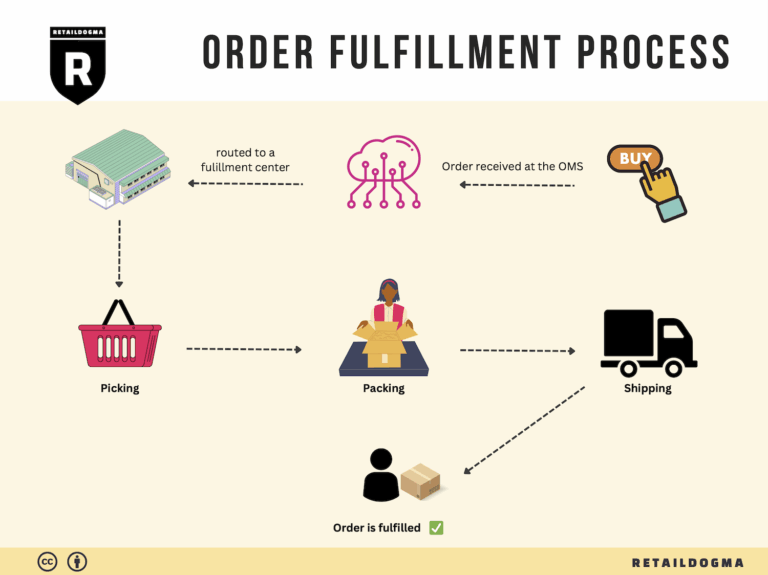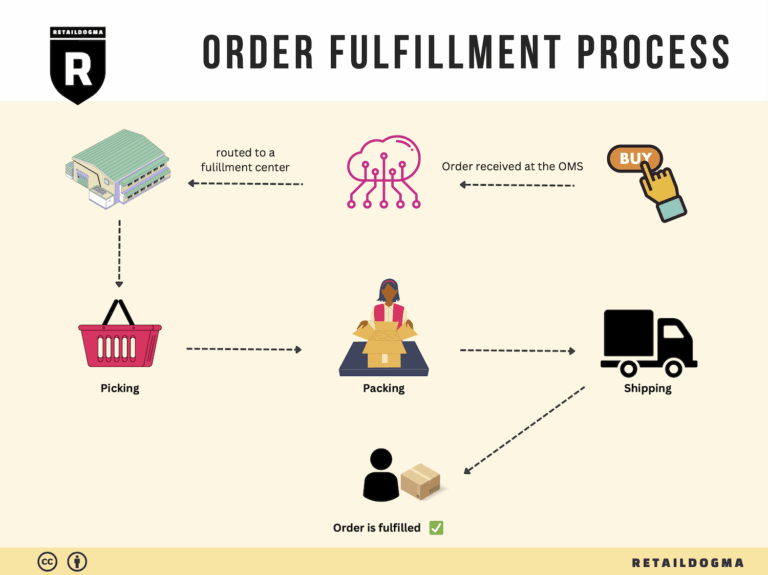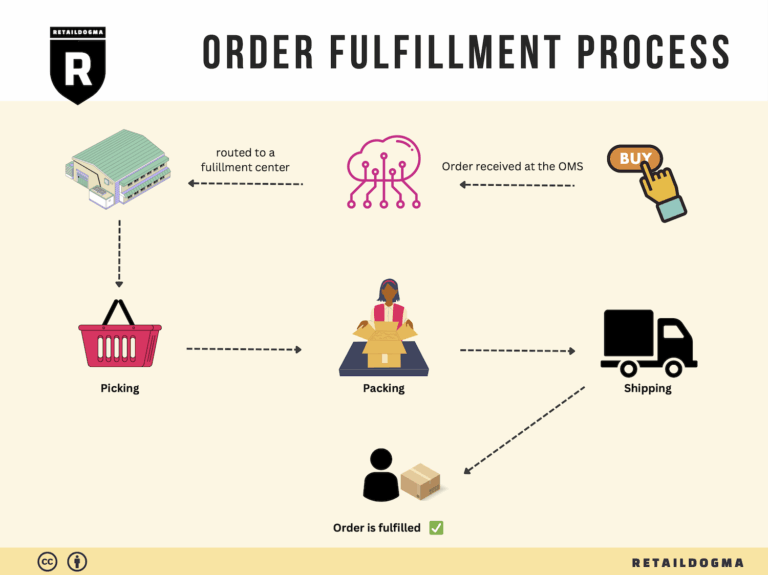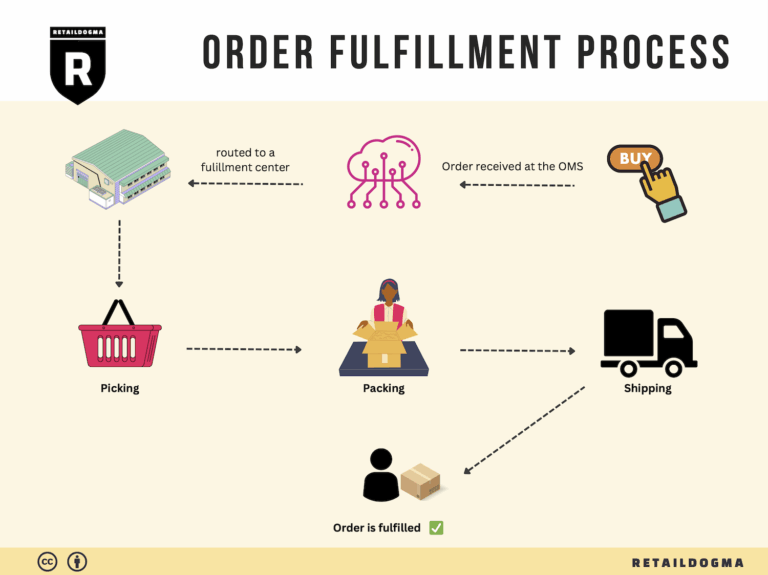What Is A Fulfillment Center? A Complete Guide (2025)
What is E-commerce Fulfillment? An Introduction for Growing Businesses
Understanding E-commerce Fulfillment
As an e-commerce business owner, the thrill of growing sales can quickly turn into an overwhelming challenge when it comes to packing and shipping orders. Managing the logistics of getting products to customers can feel like an uphill battle, especially as order volumes increase. This is where e-commerce fulfillment comes into play. Simply put, fulfillment is the process of receiving, processing, and delivering products to customers. It encompasses everything from inventory management to shipping and handling returns.
In today’s competitive landscape, understanding the various fulfillment models is crucial for scaling your business effectively. This guide will delve into different fulfillment options, including Third-Party Logistics (3PL) and Fulfillment by Amazon (FBA). Each model has its unique advantages and considerations, and choosing the right one can significantly impact your operations and customer satisfaction.
We will also explore the core services associated with e-commerce fulfillment. These services typically include inventory storage, order processing, packing, shipping, and returns management. By breaking down these components, you’ll gain insights into how each aspect contributes to a smooth fulfillment process and enhances the overall customer experience.
Selecting a fulfillment partner is another critical decision for growing businesses. This guide will provide practical tips on what to look for in a partner, such as scalability, technology integration, and service reliability. Understanding these factors can help you make an informed decision that aligns with your business goals.
Pricing is often a significant concern for e-commerce entrepreneurs. We will cover various pricing structures associated with fulfillment services, helping you to evaluate costs and budget effectively. Understanding how pricing works can empower you to choose a model that not only meets your operational needs but also fits within your financial plan.
Ultimately, this guide aims to empower your business to make smart, strategic decisions about your logistics. By understanding the nuances of e-commerce fulfillment, you can streamline your operations, enhance customer satisfaction, and position your business for sustainable growth. Whether you’re just starting out or looking to scale, the insights provided here will help you navigate the complexities of fulfillment with confidence.
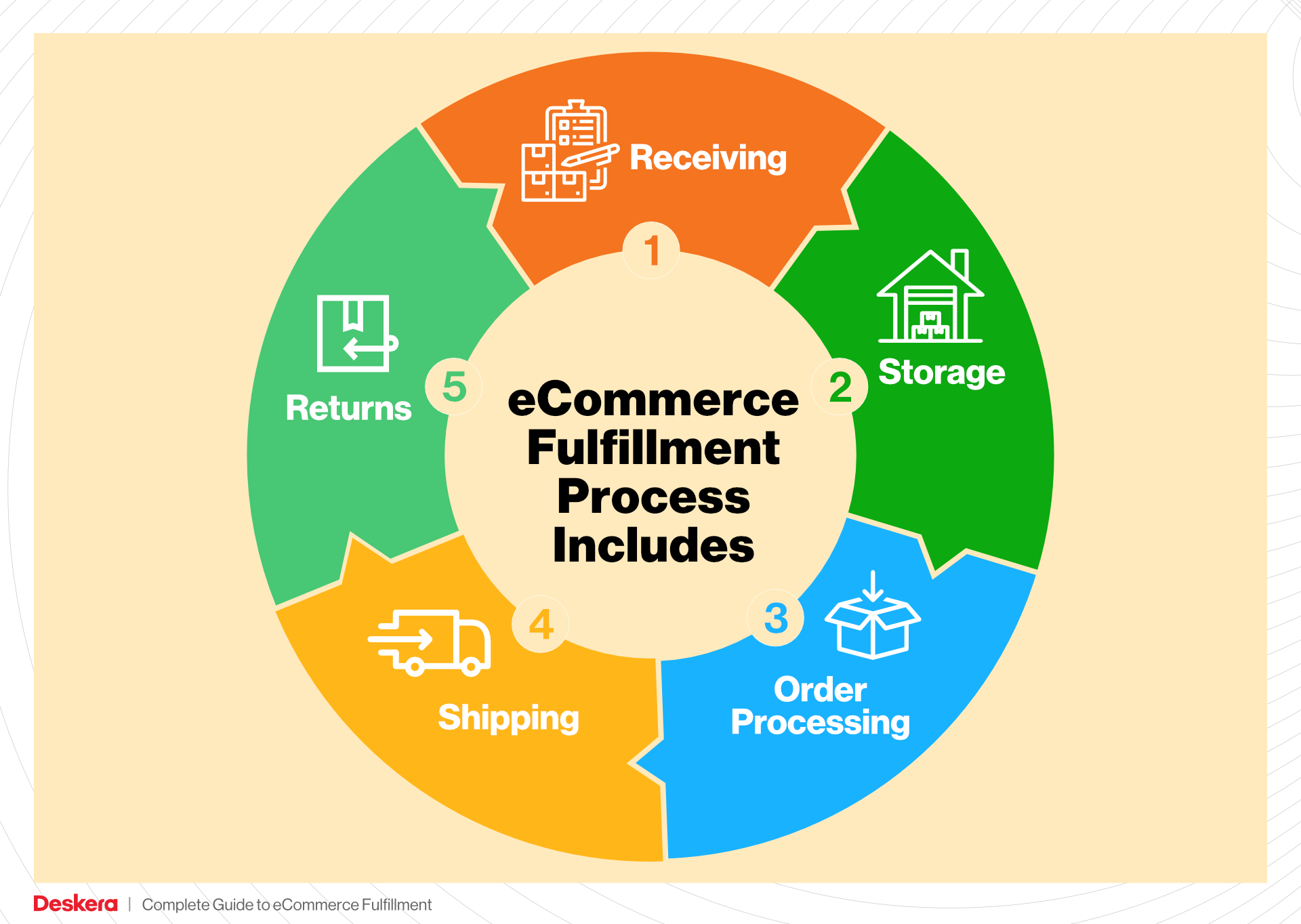
What You’ll Learn In This Guide
- What is E-commerce Fulfillment? An Introduction for Growing Businesses
- The Order Fulfillment Process: From ‘Buy’ Button to Customer’s Door
- Comparing Fulfillment Models: In-House vs. 3PL vs. Dropshipping
- A Deep Dive into Amazon FBA: Pros, Cons, and Who It’s For
- Core Services Offered by Fulfillment Centers
- How to Choose a Fulfillment Partner: A 6-Point Checklist
- Understanding Fulfillment Pricing: A Breakdown of Common Fees
- Frequently Asked Questions (FAQs) about Fulfillment
- Conclusion: Is Outsourcing Fulfillment the Right Move for Your Business?
- Important Disclaimer
The Order Fulfillment Process: From ‘Buy’ Button to Customer’s Door
1. Receiving Inventory
The order fulfillment process begins with receiving inventory at an Amazon Fulfillment Center. This step is crucial because it sets the foundation for efficient order processing. When products arrive, they are checked against purchase orders to ensure the correct quantities and items have been delivered. Each item is scanned and assigned a Stock Keeping Unit (SKU), which is a unique identifier that helps track inventory throughout the fulfillment process.
Proper receiving procedures are essential for minimizing discrepancies and ensuring that inventory records are accurate. This step also involves inspecting the goods for damage and logging any issues, which can prevent future problems down the line. Efficient receiving processes can significantly reduce lead times and improve overall inventory management.
2. Warehouse Storage
After inventory is received, the next step is warehouse storage. This involves strategically placing products within the fulfillment center to optimize space and facilitate efficient order picking. Items are stored in designated locations, often organized by category, size, or sales velocity.
Utilizing advanced Warehouse Management Systems (WMS) can significantly enhance this process. A WMS can automate storage decisions, ensuring that high-demand items are easily accessible while less popular products are stored further away. Proper storage is vital for maintaining an efficient flow of goods through the fulfillment process and reducing the time spent locating items for orders.
3. Order Picking
Once a customer places an order, the next step is order picking. This is where fulfillment center employees or automated systems retrieve the ordered items from storage. A key tool in this process is the pick list, which provides detailed information about the items to be picked, including their locations within the warehouse.
Efficient order picking is crucial for meeting customer expectations regarding delivery times. The accuracy of this step directly impacts the fulfillment center’s ability to process orders quickly and accurately. Strategies such as batch picking, where multiple orders are picked simultaneously, can further enhance efficiency. Implementing technologies like barcode scanners can also minimize errors and streamline the picking process.
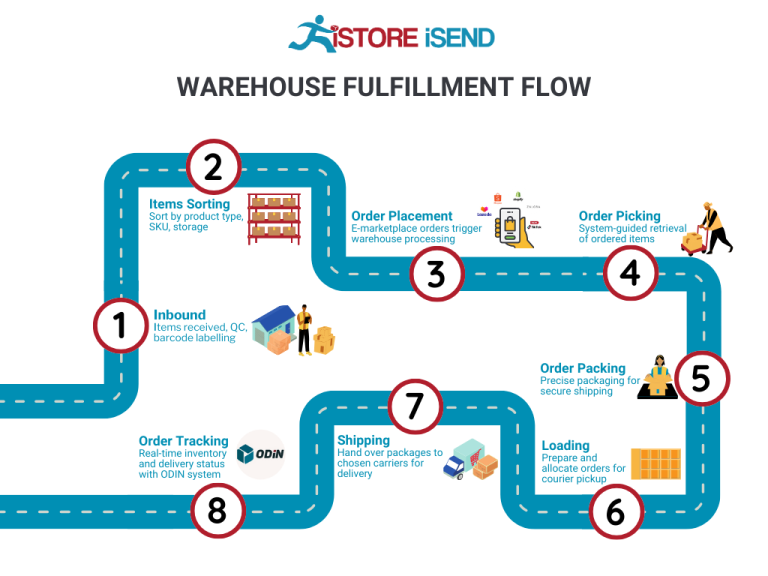
4. Order Packing
After items are picked, they move to the order packing stage. Here, products are carefully packed into shipping boxes, ensuring they are protected during transit. This step is important not only for preventing damage but also for optimizing shipping costs.
Packing techniques can vary based on the type of products being shipped. For example, fragile items may require additional cushioning, while bulkier items may need larger boxes. Utilizing packing slips and ensuring that the correct items are included in each shipment is vital for accuracy. An effective packing process can significantly enhance customer satisfaction by ensuring that products arrive in perfect condition and are correctly fulfilled.
5. Shipping & Delivery
The final step in the order fulfillment process is shipping and delivery. Once packed, orders are labeled and sorted based on their destination. This step is critical as it involves selecting the most efficient shipping methods and carriers to ensure timely delivery to the customer’s door.
Shipping management systems can help businesses track shipments, manage costs, and optimize delivery routes. Understanding different shipping options, such as standard versus expedited shipping, can also enhance customer satisfaction. The goal is to provide reliable delivery timelines that meet or exceed customer expectations. Efficient shipping practices can lead to repeat business and positive reviews, which are crucial for scaling an e-commerce operation.
By mastering these five steps—receiving inventory, warehouse storage, order picking, order packing, and shipping & delivery—e-commerce businesses can streamline their order fulfillment processes. This not only enhances operational efficiency but also improves customer satisfaction, paving the way for sustainable growth and scalability in the competitive e-commerce landscape.
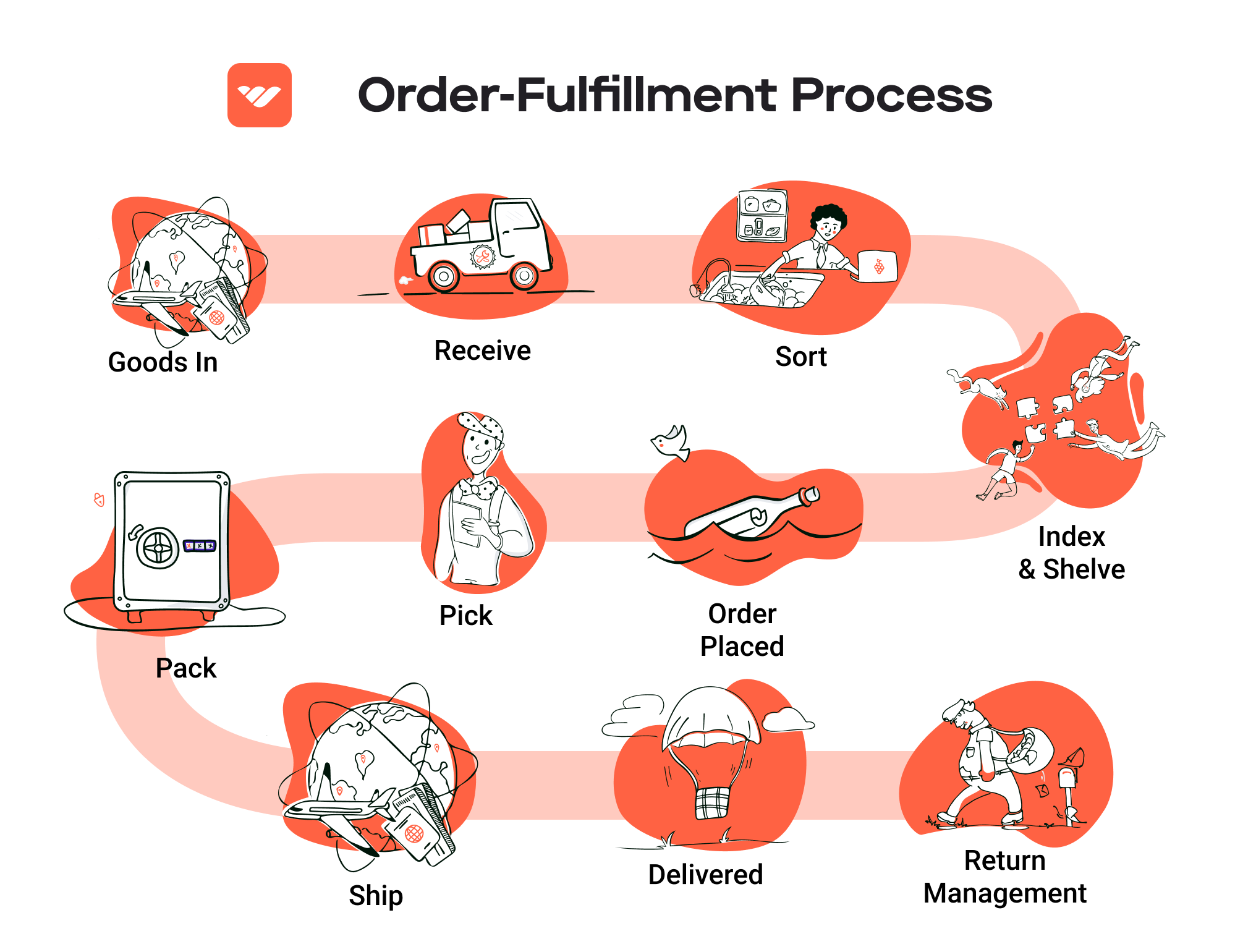
Comparing Fulfillment Models: In-House vs. 3PL vs. Dropshipping
Comparison of Fulfillment Models
| Model | Who Handles Inventory | Best For (Business Stage) | Key Advantage | Key Disadvantage |
|---|---|---|---|---|
| In-House Fulfillment | The business itself | Startups to mid-sized firms | Complete control over inventory and processes | High upfront costs and resource-intensive |
| Third-Party Logistics (3PL) | A specialized logistics provider | Growing businesses or those scaling quickly | Scalability and access to expertise | Less control over the fulfillment process |
| Dropshipping | Supplier or manufacturer | Entrepreneurs and small businesses | Low startup costs and minimal risk | Lower profit margins and less control over inventory |
In-House Fulfillment
In-house fulfillment involves managing inventory and order processing within the business itself. This model is often preferred by startups and mid-sized firms that are just beginning to establish their brand identity and want to maintain complete control over their inventory and shipping processes. The key advantage of in-house fulfillment is the ability to oversee every aspect of the fulfillment process, from inventory management to packaging and shipping. This control can lead to improved customer service, as businesses can tailor the fulfillment experience to their brand values and customer expectations.
However, in-house fulfillment comes with significant challenges. The initial investment in warehouse space, staffing, and technology can be substantial. Additionally, managing logistics can be resource-intensive, requiring dedicated personnel and operational expertise. As the business grows, the complexities of handling increased order volumes and inventory management can become overwhelming, making it difficult to maintain efficiency and customer satisfaction.
Third-Party Logistics (3PL)
Third-party logistics (3PL) providers offer businesses the opportunity to outsource their fulfillment operations to specialized logistics companies. This model is ideal for growing businesses or those looking to scale quickly without the burden of managing inventory and shipping in-house. The key advantage of using a 3PL is scalability; businesses can quickly adjust their logistics needs based on demand without the need for significant upfront investments in infrastructure.
Additionally, 3PL providers often have extensive expertise in logistics, allowing businesses to benefit from best practices and advanced technology in inventory management, shipping, and returns processing. This expertise can lead to improved operational efficiency and potentially lower shipping costs due to the provider’s established relationships with carriers.
However, the downside to using a 3PL is the reduced control over the fulfillment process. Businesses must rely on their logistics partner to meet customer expectations, which can lead to potential discrepancies in service levels. Communication and coordination are crucial, as any issues with the 3PL can directly impact the customer experience. Furthermore, businesses may face challenges in integrating their systems with those of the 3PL, requiring careful planning and execution.
Dropshipping
Dropshipping is a fulfillment model where the retailer does not hold inventory but instead relies on suppliers or manufacturers to ship products directly to customers. This model is particularly appealing to entrepreneurs and small businesses looking to minimize risk and startup costs. The primary advantage of dropshipping is the low barrier to entry; businesses can launch without investing in inventory upfront, allowing them to test market demand for products before making significant commitments.
Additionally, dropshipping allows for a diverse product offering since retailers can easily add new items to their online store without worrying about storage or inventory management. This flexibility is particularly advantageous in rapidly changing markets where consumer preferences can shift quickly.
However, dropshipping also has notable disadvantages. Profit margins can be lower compared to in-house or 3PL fulfillment, as retailers often need to share profits with suppliers. Furthermore, businesses have limited control over inventory levels and shipping times, which can lead to customer dissatisfaction if suppliers experience delays or stock shortages. As a result, maintaining quality control and ensuring a positive customer experience can be challenging in a dropshipping model.
Conclusion
Choosing the right fulfillment model is a critical decision for e-commerce businesses, each with its own set of advantages and disadvantages. In-house fulfillment offers control but requires significant resources, while 3PL provides scalability and expertise but at the cost of reduced control. Dropshipping minimizes risk and startup costs but often comes with lower profit margins and potential issues in customer satisfaction. Understanding these dynamics can help e-commerce business owners select the fulfillment strategy that aligns with their operational capabilities and growth objectives.
A Deep Dive into Amazon FBA: Pros, Cons, and Who It’s For
Understanding Fulfillment by Amazon (FBA)
Fulfillment by Amazon (FBA) is a service offered by Amazon that allows sellers to store their products in Amazon’s fulfillment centers. When a customer places an order for one of these products, Amazon takes care of the storage, packaging, and shipping. This service streamlines the e-commerce process for sellers, enabling them to focus on other aspects of their business, such as marketing and product development.
How FBA Works
-
Setup and Inventory Management: Sellers create an Amazon seller account and list their products. They then ship their inventory to one or more of Amazon’s fulfillment centers. Sellers can monitor their inventory levels through the Amazon Seller Central dashboard.
-
Storage and Fulfillment: Once the products are received at the fulfillment center, they are stored until a customer orders them. When an order is placed, Amazon picks, packs, and ships the product on behalf of the seller.
-
Customer Service and Returns: Amazon also handles customer service inquiries and returns for FBA products. This includes managing refunds and exchanges, which can significantly reduce the workload for sellers.
-
Sales Channels: FBA can be used for sales on Amazon as well as other platforms, allowing sellers to leverage Amazon’s logistics capabilities across various sales channels.
Pros of Using FBA
1. Prime Eligibility
Products fulfilled by Amazon are eligible for Amazon Prime, which can dramatically increase visibility and sales. Prime members often prefer to purchase products that qualify for free two-day shipping, leading to higher conversion rates.
2. Customer Trust
Amazon has built a strong reputation for reliability and customer service. By using FBA, sellers can leverage this trust, as customers are more likely to buy from sellers that offer Amazon’s fulfillment service.
3. Multi-Channel Fulfillment
FBA allows sellers to fulfill orders not just from Amazon but from other e-commerce platforms as well. This flexibility enables businesses to streamline their logistics and manage inventory more efficiently across various sales channels.
4. Scalability
FBA provides a scalable solution for growing businesses. As sales increase, sellers can easily send more inventory to Amazon without needing to invest in additional warehouse space or logistics infrastructure.
5. Time Savings
Outsourcing fulfillment to Amazon frees up valuable time for sellers, allowing them to focus on product sourcing, marketing, and customer engagement rather than logistics.
Cons of Using FBA
1. High Fees
FBA involves several fees, including storage fees and fulfillment fees. These costs can add up quickly, particularly for sellers with low-margin products. It’s crucial for sellers to analyze their pricing strategy and profit margins to ensure that FBA remains financially viable.
2. Strict Inventory Rules
Amazon imposes strict rules regarding inventory management. Sellers must ensure that their products meet Amazon’s quality standards and comply with its policies. Failure to comply can result in penalties, including removal of inventory or suspension of selling privileges.
3. Commingling Risks
FBA uses a system where products from multiple sellers may be stored together. This commingling can pose risks for sellers, such as the possibility of receiving returns from customers that are not their products. This can impact brand reputation and customer satisfaction.
4. Limited Control Over Branding
When using FBA, sellers have limited control over how their products are packaged and presented. This can dilute brand identity, as products are shipped in Amazon-branded packaging, which may not align with the seller’s branding strategy.
5. Inventory Management Challenges
Sellers must be vigilant about inventory levels. Overstocking can lead to high storage fees, while understocking can result in stockouts and lost sales. Effective inventory management is essential to mitigate these risks.
Who is FBA Best For?
Fulfillment by Amazon is particularly advantageous for:
-
Small to Medium-Sized Businesses: Businesses that lack the infrastructure to manage logistics can benefit significantly from FBA. It allows them to compete with larger retailers without the burden of managing fulfillment.
-
E-commerce Entrepreneurs: Startups and entrepreneurs looking to quickly scale their operations can leverage FBA’s capabilities without upfront investment in warehouses or logistics.
-
Sellers with High Demand Products: Businesses with popular products that are likely to sell quickly can benefit from FBA’s fast shipping and Prime eligibility, leading to increased sales.
-
Multi-Channel Sellers: Businesses selling on multiple platforms (e.g., eBay, Shopify) can streamline their fulfillment processes using FBA, allowing them to focus on growing their brand across channels.
-
International Sellers: Companies looking to enter the U.S. market can use FBA to handle logistics, reducing the complexities of international shipping and customs.
In conclusion, while FBA offers numerous advantages for e-commerce sellers, it is essential to weigh these benefits against the potential drawbacks. Understanding the intricacies of FBA and how it aligns with your business goals is crucial for making an informed decision. For many sellers, FBA provides a powerful tool to enhance efficiency and drive growth in a competitive marketplace.
Core Services Offered by Fulfillment Centers
Inventory Management & Warehousing
Fulfillment centers provide robust inventory management and warehousing solutions that form the backbone of efficient e-commerce operations. These centers utilize advanced technology and software systems to track inventory levels in real-time, ensuring that stock levels are optimized and that products are readily available for shipping.
Benefits:
1. Real-Time Visibility: E-commerce businesses can monitor inventory levels across various locations, facilitating better forecasting and purchasing decisions.
2. Space Optimization: By utilizing a fulfillment center, businesses can free up valuable warehouse space that can be repurposed for other operational needs. This is particularly advantageous for small to medium-sized businesses that may not have the capital to invest in large warehousing facilities.
3. Scalability: As businesses grow, fulfillment centers can easily accommodate increased inventory levels without the need for significant investment in physical space or additional staff. This flexibility supports rapid scaling, which is crucial for e-commerce success.
Pick and Pack Services
Pick and pack services are essential for preparing orders for shipment. This process involves selecting the correct items from inventory (picking) and then packaging them appropriately for delivery (packing). Fulfillment centers employ trained staff and automated systems to enhance the efficiency and accuracy of this process.
Benefits:
1. Efficiency: Fulfillment centers streamline the pick and pack process, significantly reducing the time taken to fulfill orders. This leads to faster shipping times, enhancing customer satisfaction and loyalty.
2. Accuracy: Automated picking systems reduce human error, ensuring that customers receive the correct items. This accuracy is crucial for maintaining a positive brand reputation and minimizing returns.
3. Customization: Many fulfillment centers offer custom packaging options, allowing businesses to enhance their brand presence through unique packaging designs. This can help differentiate a brand in a crowded marketplace.
Kitting and Assembly
Kitting and assembly services involve combining multiple items into a single package or product before shipping. This is particularly useful for businesses that sell products that need to be bundled together, such as promotional kits or product sets.
Benefits:
1. Streamlined Operations: By outsourcing kitting and assembly to fulfillment centers, businesses can focus on their core competencies, such as marketing and product development, rather than the logistical complexities of assembling products.
2. Cost-Effectiveness: Fulfillment centers often have the resources and expertise to perform kitting and assembly more cost-effectively than individual businesses could manage in-house. This can lead to significant savings in labor and overhead costs.
3. Improved Customer Experience: Delivering products that are ready to use or enjoy can enhance the customer experience, as buyers receive exactly what they expect without additional assembly or setup.
Returns Management (Reverse Logistics)
Returns management, often referred to as reverse logistics, is a critical service provided by fulfillment centers. It involves handling the return of goods from customers back to the inventory, managing the process efficiently, and determining the best course of action for returned items (resale, refurbishment, or recycling).
Benefits:
1. Enhanced Customer Trust: A well-managed return process can significantly improve customer trust and satisfaction. Customers are more likely to make a purchase when they know they can easily return items if necessary.
2. Operational Efficiency: Fulfillment centers can process returns swiftly and accurately, minimizing the operational burden on e-commerce businesses. This allows businesses to focus on growth while ensuring that returns are handled professionally.
3. Data Insights: Analyzing return data can provide valuable insights into customer behavior and product quality. This information can help businesses make informed decisions about inventory management, product offerings, and marketing strategies.
Conclusion
Utilizing a fulfillment center can dramatically enhance the operational efficiency of e-commerce businesses. From effective inventory management and streamlined pick and pack services to specialized kitting and robust returns management, fulfillment centers offer a suite of services that can help businesses scale and thrive in a competitive marketplace. By leveraging these core services, e-commerce entrepreneurs can focus on growth and customer satisfaction, ensuring long-term success in their ventures.
How to Choose a Fulfillment Partner: A 6-Point Checklist
Location & Warehouse Network
Importance: The geographical location of your fulfillment partner’s warehouses directly impacts shipping times, costs, and overall customer satisfaction. A strategically positioned warehouse network can minimize shipping distances, leading to faster deliveries and reduced shipping expenses.
Questions to Ask:
1. Where are your fulfillment centers located, and how does this align with my target market?
2. Do you have warehouses in multiple regions to facilitate faster shipping?
3. How do you manage inventory distribution across your locations?
4. Can you provide insights on shipping times based on your network?
Technology & Integrations
Importance: A fulfillment partner’s technology stack should seamlessly integrate with your existing e-commerce platform and tools. This ensures real-time inventory updates, order tracking, and streamlined operations.
Questions to Ask:
1. What technology do you use for order management and inventory tracking?
2. Can your system integrate with my e-commerce platform (e.g., Shopify, WooCommerce, Amazon)?
3. Do you offer an API for custom integrations?
4. How do you handle data security and compliance with regulations?
Specializations (e.g., cold storage, oversized items)
Importance: Different businesses have unique product requirements. Choosing a partner with the right specializations ensures that your products are stored and handled appropriately, maintaining quality and compliance.
Questions to Ask:
1. Do you specialize in any particular types of products (e.g., perishable goods, fragile items, oversized products)?
2. What facilities do you have for temperature-sensitive items?
3. How do you ensure that specialized items are handled properly?
4. Can you provide case studies or examples of similar businesses you have worked with?
Scalability & Capacity
Importance: As your business grows, your fulfillment needs will likely change. It’s crucial to partner with a provider that can scale with you, whether that means expanding warehouse space or adapting to seasonal fluctuations in demand.
Questions to Ask:
1. What is your current capacity, and how do you manage peak seasons?
2. How quickly can you scale operations to accommodate increased order volumes?
3. Do you have contingency plans in place for unexpected demand spikes?
4. Can you handle additional services like kitting or custom packaging as my needs evolve?
Pricing and Contracts
Importance: Understanding pricing structures and contract terms is vital for budgeting and avoiding hidden fees. Transparent pricing helps you make informed decisions and ensures that you get value for your investment.
Questions to Ask:
1. What is your pricing model (e.g., per order, per item, monthly fees)?
2. Are there any hidden fees (e.g., storage fees, handling fees)?
3. What are the terms of your contract, and is there flexibility for renegotiation?
4. How do you handle pricing changes, and how will I be notified?
Customer Support & Reviews
Importance: Reliable customer support is essential for resolving issues swiftly and maintaining smooth operations. Additionally, understanding a partner’s reputation through reviews can provide insights into their reliability and service quality.
Questions to Ask:
1. What customer support channels do you offer (e.g., phone, email, chat)?
2. What are your average response times for customer inquiries?
3. Can you provide references or testimonials from current clients?
4. How do you handle disputes or issues that arise during the fulfillment process?
By considering these six critical factors, e-commerce businesses can make informed decisions when selecting a fulfillment partner. Each element plays a pivotal role in ensuring that your logistics operations align with your business goals, enhance customer satisfaction, and ultimately drive growth. Always remember that a successful partnership is built on clear communication, shared values, and a commitment to meeting customer expectations.
Understanding Fulfillment Pricing: A Breakdown of Common Fees
Initial Setup Fees
When you start using an Amazon Fulfillment Center, there may be initial setup fees involved. These fees are typically one-time charges that cover the administrative costs associated with onboarding your products into the Fulfillment by Amazon (FBA) system. The setup process may include registering your seller account, configuring your inventory settings, and integrating your product listings with Amazon’s platform.
The calculation of initial setup fees can vary based on the complexity of your inventory and the number of SKUs you intend to manage. Typically, these fees range from a few hundred to several thousand dollars, depending on your specific needs and whether you require any additional services such as labeling or packaging.
Receiving Fees
Receiving fees are charged when your products arrive at an Amazon Fulfillment Center. These fees cover the costs associated with unloading, inspecting, and storing your inventory. When goods are delivered, they undergo a receiving process where they are checked against the shipping documentation to ensure accuracy.
Receiving fees are generally calculated based on the number of units received and can vary by fulfillment center location. For example, a standard fee might be applied per pallet or per item received. Businesses should be aware that discrepancies in shipment quantities can lead to additional fees, so accurate inventory management is crucial to minimize costs.
Storage Fees (per pallet/bin)
Storage fees are charged for the space your inventory occupies within the fulfillment center. Amazon typically assesses storage fees monthly, and they can be categorized into standard storage and long-term storage. Standard storage fees are applied to items stored for less than six months, while long-term storage fees kick in for items stored for more than six months.
The fees are usually calculated on a per-cubic-foot basis or per pallet/bin. For instance, businesses might encounter a lower rate for standard storage but higher rates for long-term storage, making it essential to manage inventory turnover effectively. To avoid incurring long-term storage fees, consider implementing strategies such as regular inventory audits and promotional campaigns to move slow-moving items.
Pick & Pack Fees (per item/order)
Pick and pack fees are incurred each time an order is processed at the fulfillment center. This fee covers the costs of retrieving items from storage (picking) and packing them for shipment to customers. The fees can vary based on the size and weight of the items, as well as the complexity of the order.
Typically, pick and pack fees are calculated on a per-item basis, with additional charges for special handling or packaging requirements. For example, larger or heavier items may incur higher fees due to the increased labor and material costs associated with their handling. Businesses should optimize their product offerings to reduce the number of unique SKUs, as this can help streamline the picking process and potentially lower costs.
Shipping Fees
Shipping fees are one of the most significant components of fulfillment pricing. These fees are charged for the transportation of goods from the fulfillment center to the end customer. The cost of shipping can vary based on factors such as the destination, shipping speed, weight, and dimensions of the package.
Amazon typically offers various shipping options, including standard, expedited, and two-day shipping, each with different price points. It’s important for businesses to understand how shipping costs are calculated, as they can significantly impact profit margins. Utilizing Amazon’s discounted shipping rates can help reduce overall expenses, but businesses should also consider their own shipping strategies, including the use of third-party logistics providers if it proves more cost-effective.
Tips for Getting an Accurate Quote
To obtain an accurate quote for fulfillment pricing, businesses should follow these practical steps:
-
Assess Your Inventory Needs: Understand your product dimensions, weights, and quantities to provide accurate information when requesting quotes.
-
Evaluate Your Sales Projections: Consider your expected sales volume to anticipate storage and handling needs accurately.
-
Inquire About Additional Services: Be clear about any additional services you may require, such as labeling or special packaging, as these can affect pricing.
-
Request Multiple Quotes: Don’t hesitate to reach out to multiple fulfillment centers to compare pricing structures and services offered.
-
Understand Pricing Models: Familiarize yourself with the different pricing models and how they apply to your business to make informed decisions.
-
Negotiate Terms: If you anticipate high volumes, discuss potential discounts or negotiated rates with fulfillment providers.
By carefully analyzing these aspects, businesses can secure a more accurate and favorable fulfillment pricing structure that supports their growth objectives.
Frequently Asked Questions (FAQs) about Fulfillment
1. What is an Amazon Fulfillment Center?
An Amazon Fulfillment Center is a large warehouse where Amazon stores products and manages inventory for sellers using Fulfillment by Amazon (FBA). These centers handle the storage, packaging, and shipping of products directly to customers, enabling sellers to leverage Amazon’s extensive logistics network.
2. What’s the difference between a warehouse and a fulfillment center?
While both warehouses and fulfillment centers store goods, their purposes differ significantly. A warehouse primarily focuses on storing products for long-term inventory management, whereas a fulfillment center is geared towards processing and shipping orders quickly to customers, often with a focus on e-commerce operations.
3. How does the fulfillment process work at Amazon?
The fulfillment process at Amazon typically involves several steps:
1. Receiving Inventory: Products are delivered to the fulfillment center.
2. Storage: Items are stored in designated areas within the center.
3. Order Processing: When a customer places an order, the system locates the item in the warehouse.
4. Picking and Packing: Warehouse staff pick the item and package it for shipment.
5. Shipping: The packaged order is sent to the customer via Amazon’s logistics network.
4. What is a 3PL (Third-Party Logistics)?
A 3PL is a service provider that offers logistics and supply chain management services to businesses. These services can include inventory management, warehousing, order fulfillment, shipping, and transportation. Many e-commerce sellers use 3PLs to streamline their operations and focus on core business activities.
5. How much do fulfillment services cost?
Fulfillment service costs can vary based on several factors, including:
– Storage Fees: Charged per cubic foot of space occupied by your inventory.
– Pick and Pack Fees: Charged per order or per item picked and packed for shipping.
– Shipping Costs: Determined by the weight, dimensions, and destination of the package.
On average, sellers should expect to pay anywhere from $2 to $5 per order, plus additional fees for storage and shipping.
6. What are the advantages of using Amazon Fulfillment Centers?
Using Amazon Fulfillment Centers provides several advantages, including:
– Fast Shipping: Access to Amazon Prime and faster delivery options enhances customer satisfaction.
– Scalability: Sellers can easily scale their operations without investing in physical infrastructure.
– Inventory Management: Amazon’s sophisticated inventory tracking systems help manage stock levels efficiently.
– Customer Service: Amazon handles customer inquiries and returns, reducing the operational burden on sellers.
7. How can I track my inventory at Amazon Fulfillment Centers?
Sellers can track their inventory through the Amazon Seller Central dashboard. This platform provides real-time updates on stock levels, order statuses, and fulfillment metrics, allowing sellers to monitor their inventory effectively and make informed decisions about restocking.
8. What types of products can I send to Amazon Fulfillment Centers?
Most physical products can be sent to Amazon Fulfillment Centers, provided they comply with Amazon’s policies. This includes items such as electronics, clothing, home goods, and more. However, certain categories may have restrictions or require additional documentation, so it’s essential to review Amazon’s guidelines before shipping.
9. How long does it take to receive inventory at an Amazon Fulfillment Center?
The time it takes to receive inventory can vary based on several factors, including shipping method, distance, and the current workload at the fulfillment center. Generally, once your shipment arrives, it may take 1-2 days for Amazon to process and make the inventory available for sale.
10. What should I do if my inventory is damaged or lost at an Amazon Fulfillment Center?
If your inventory is damaged or lost, you should file a claim through Amazon Seller Central. Amazon has specific procedures in place for reporting issues with inventory, and they may reimburse sellers for lost or damaged goods in accordance with their policies. It’s advisable to keep thorough records of your inventory and shipments to support your claim.
Conclusion: Is Outsourcing Fulfillment the Right Move for Your Business?
Evaluating the Benefits of Outsourcing Fulfillment
Outsourcing fulfillment can be a transformative decision for your e-commerce business, offering a range of benefits that can significantly enhance your operational efficiency. Firstly, one of the most compelling advantages is time savings. By delegating logistics to a specialized fulfillment service, you free up valuable time to focus on core business activities, such as marketing, product development, and customer engagement. This is especially crucial for small to medium-sized businesses looking to scale without the burden of managing complex logistics.
Another critical benefit is scalability. As your business grows, your fulfillment needs will likely become more complex. Partnering with a fulfillment service allows you to adjust your logistics operations in real-time, accommodating fluctuations in order volume without the need for significant capital investment in infrastructure. This flexibility is essential for businesses aiming to capitalize on market opportunities swiftly.
Furthermore, outsourcing fulfillment brings expertise to your operations. Fulfillment partners often have advanced technology and established best practices that enhance order accuracy, speed, and customer satisfaction. Their experience in managing diverse logistics challenges can help you navigate complexities that may arise, ensuring a smooth supply chain process.
However, it is vital to emphasize the importance of choosing the right fulfillment partner. Your partner should align with your business goals and provide the level of service that meets your customers’ expectations. Conduct thorough research and consider factors such as location, technology integration, and customer service responsiveness.
Take Action Now
To determine if outsourcing fulfillment is the right strategic move for your business, conduct a thorough audit of your current shipping processes. Evaluate your order management, shipping times, and customer feedback. This analysis will help you identify inefficiencies and assess whether a fulfillment partner could drive your growth and success. Don’t hesitate to explore options that could streamline your operations and enhance your customer experience. The right fulfillment partner could be the key to unlocking your business’s full potential.
Important Disclaimer
⚠️ Important Disclaimer
The information in this guide is for educational purposes. Fulfillment services, pricing, and platform features change frequently. Always conduct your own due diligence and consult with providers directly before making business decisions.
